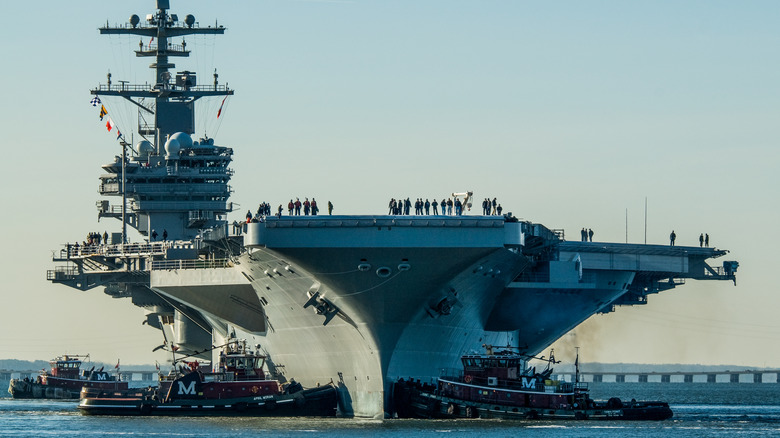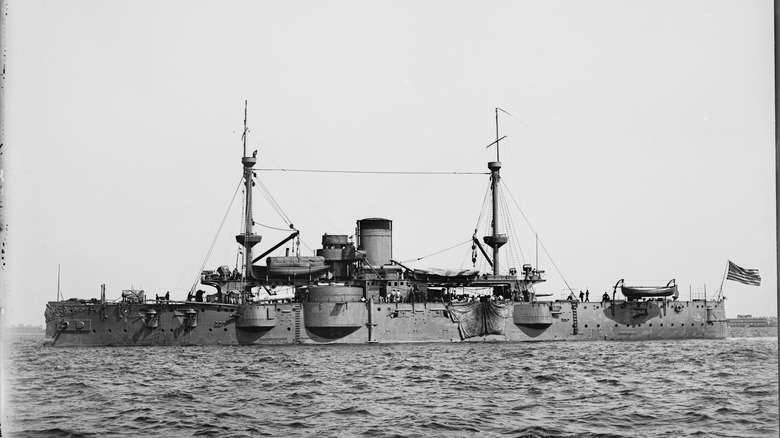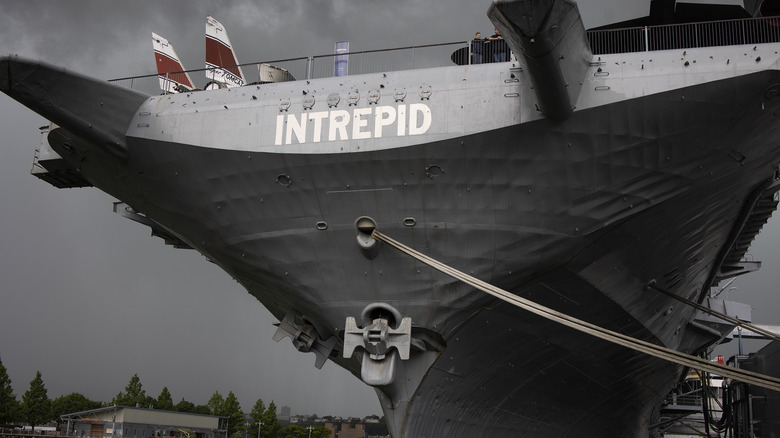Why The U.S. Military Doesn't Use Battleships Anymore
There are few military vessels historically as imposing as the battleship. Guinness World Records declares that the biggest battleships ever were the Musashi and Yamato, which were armed with nine 362,880 lb guns and were 863 feet long. Both Japanese powerhouses were sunk during World War II, in the wake of which aircraft developed an ever-increasing prominence in combat.
Shows of sheer, gigantic force can certainly be effective deterrents. As the face of warfare has changed with technology, though, certain monsters have demonstrated that they may no longer be a fit for what militaries need. The mighty Corvair B-36 Peacemaker bomber, which boasted almost one dozen engines, ultimately became impractical as new technology was introduced, and this appears true of conventional battleships.
The U.S. military, never a force to compromise on spectacle or afraid to innovate, appears to have seen the writing on the wall. It's exactly this that has led to battleships becoming increasingly impractical.
One iconic battleship, Dreadnought VII of the Royal Navy, was created in 1906, a 20,730 ton metal brute of a steam age vessel. During the era, such ships began to define themselves as the biggest bruisers of a naval force. In "The Battleship Book," Robert Farley notes that "the notion that a warship could go from being world class to obsolete in a decade is almost entirely alien to modern sensibilities." Here's what went so wrong for the era-defining Dreadnought and the battleships that followed.
Could battleships' defenses hold up to new threats?
Battleships such as the vast Yamato and Musashi of Japan's World War II fleet would ultimately encounter two major issues. Firstly, through technological breakthroughs, better weapons would become available in more practical, efficient, smaller packages. Secondly, that technology would be incompatible with a battleship's historical purpose: protracted, destructive combat.
Just as the onset of guns rendered knight's armor and fortified castles largely obsolete, the introduction and refinement of the likes of intercontinental ballistic missiles — the United States' first such weapon was the Atlas SM-65, which was developed by the United States Air Force and first used in 1959 — meant that battleships' weapons, though certainly potent were rendered less practical to use, and their armor rather less effective against the likes of these new threats.
Maneuverability, stealth, and advanced threat detection systems became a heavy military focus as the decades went on and technology allowed. The larger a ship, though, the more expensive and less practical it would be to provide a suite of defenses, and ever-more-sophisticated assaults from a range of aggressors would see a huge battleship as a huge target.
Battleships in a rather different sense
Financial concerns, overall, were paramount too. Farley notes in "The Battleship Book" that ballooning crew numbers dramatically increased costs, while "smaller ships had smaller crews, and less demanding training requirements." A battleship's primary purpose was to carry and administer as much powerful weaponry as possible, but the maneuverability and increased subtlety of still-powerful smaller vessels has become more valuable.
In August 2022, the U.S. Navy chose Ingalls Shipbuilding to equip the destroyers USS Michael Monsoor and USS Zumwalt with hypersonic missiles. When the work is completed — expected to begin in October of 2023 — these ships are seen as the Navy's future.
In an era where air supremacy is key (with aircraft often equipped with long-ranged, guided missiles), the battleship's place has had to be redefined. The likes of submarines and cruisers are still a vital part of any powerful naval force, and they have steadily evolved over time too. A new U.K. Dreadnought class, named in honor of 1906's, in fact, was a line of ballistic missile submarines.
The iconic battleships of the early-to-mid twentieth century, in short, became rather too big for their own good. Vast ships with wide arrays of weaponry tend to require similarly huge crews, and this would be more difficult to sustain. With the nature of newer weapons in mind, the more efficient, maneuverable vessels are better suited to defend against evolving threats.


